| Columns Retired Columns & Blogs |
McIntosh MC501 monoblock power amplifier Measurements
Sidebar 3: Measurements
The McIntosh MC501 is unusual for a solid-state amplifier in that it uses an output transformer. This has three separate taps, one each optimized for 8, 4, and 2 ohm speakers. I hooked up my 8 ohm dummy load to the MC501's 8 ohm tap, and, following my usual practice, set the amplifier running at one-third power for one hour, to see how well it would deal with thermal stress. To my surprise, the McIntosh shut itself off after just five minutes—the orange Power Guard LED on the front panel illuminated, and the rear-panel heatsinks were too hot to touch. After the amp had cooled down, it turned itself on again. I tried running it at a lower level, just 30W into 8 ohms. This time it turned itself off after 20 minutes; again, the heatsinks were too hot to touch.
The heatsinks are relatively small for an amplifier with a continuous rating of 500W. I must assume that McIntosh decided that continuous running with sinewaves would be sufficiently rare that they could economize in this area. When this circumstance did arise, their Sentry Monitor circuit, which monitors heatsink temperature, would protect the amplifier against thermal runaway.
Measured via its balanced input, the MC501's voltage gain was low, at 23.3dB from the 8 ohm tap into 8 ohms, 20.64dB from the 4 ohm tap into 4 ohms, and 16.8dB from the 2 ohm tap into 2 ohms. Several volts will therefore be required from a balanced preamplifier to drive the Mac to its maximum output power. Unusually but conforming to the specification, the unbalanced gains were 6dB higher, meaning that unbalanced preamplifiers will not have to deliver quite so high an output voltage. Both inputs preserved absolute polarity (the XLR jack is wired with pin 2 hot), and the input impedance at 1kHz measured 9.15k ohms unbalanced, 18.3k ohms balanced—on the low side for some capacitor-coupled tube preamplifiers, such as the BAT models.
The lower-than-normal gain is associated with an extremely low noise floor. Even the wideband, unweighted figure ref. 1W into 8 ohms from the 8 ohm tap was 90dB; switching in an A-weighting filter improved the figure to 104.6dB. The MC501 is one of the few amplifiers that can match the theoretical dynamic range of such hi-rez digital media as SACD and DVD-Audio.
When I measured the MC501's output impedance, I was surprised to find it to be lowest from the 8 ohm tap, at 0.08 ohm, and highest from the 2 ohm tap, at 0.13 ohm (both figures include 6' of speaker cable)—the opposite of what I expected. These values held from 20Hz to 1kHz; there was a slight rise from all three taps at the top of the audioband to 0.16 ohm.
These low source impedances mean that any variation in frequency response due to the Ohm's Law interaction between them and the variation in impedance with frequency of a typical speaker will be ±0.1dB or less, as can be seen from the top trace in fig.1. This graph shows the family of responses from the 8 ohm tap. The amplifier's bandwidth decreases with decreasing load impedances, but when the output tap is matched to the load, the -3dB point lies at 120kHz (8 ohm tap), 100kHz (4 ohm tap), and 68kHz (2 ohm tap). This is superb performance for an amplifier with an output transformer. As a result of this wide bandwidth, the MC501's reproduction of 1kHz (fig.2) and 10kHz (fig.3) squarewaves was essentially perfect.
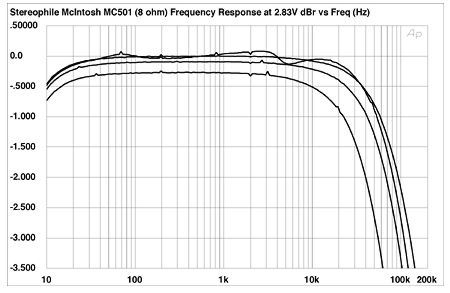
Fig.1 McIntosh MC501, 8 ohm tap, frequency response at 2.83V into (from top to bottom at 2kHz): simulated loudspeaker load, 8 ohms, 4 ohms, 2 ohms (0.5dB/vertical div.).
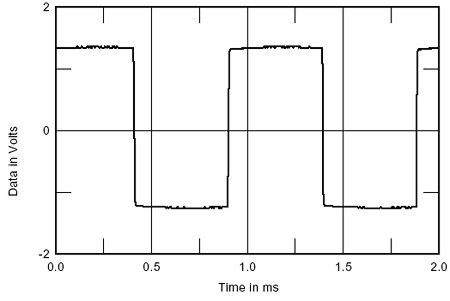
Fig.2 McIntosh MC501, 8 ohm tap, small-signal 1kHz squarewave into 8 ohms.

Fig.3 McIntosh MC501, 8 ohm tap, small-signal 10kHz squarewave into 8 ohms.
The McIntosh's maximum output power depended on the output tap chosen and the load, but when the tap was matched to the load, the amplifier easily exceeded its specified 500W at our 1% THD definition of clipping. The 8 ohm tap delivered no less than 720W into 8 ohms (28.6dBW), for example (fig.4), with similar deliveries into 4 and 2 ohms from their respective taps (figs.5 and 6). Despite the slight increase in source impedance, the MC501's ability to deliver current into the speaker load did increase with the decreasing output transformer tap. The 8 ohm tap was limited to 225W into 2 ohms (17.5dBW), for example, while the 4 ohm tap delivered 1000W (24dBW), the 2 ohm tap 630W (22dBW).
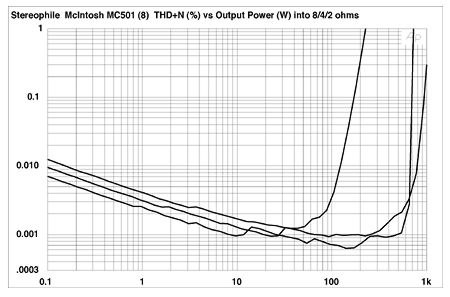
Fig.4 McIntosh MC501, 8 ohm tap, distortion (%) vs 1kHz continuous output power into (from bottom to top at 10W): 8 ohms, 4 ohms, 2 ohms.
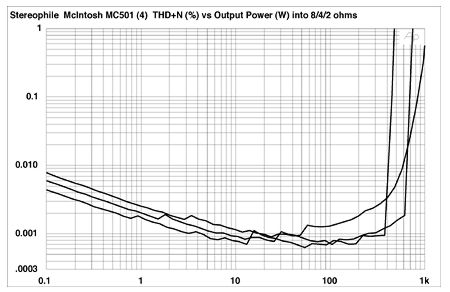
Fig.5 McIntosh MC501, 4 ohm tap, distortion (%) vs 1kHz continuous output power into (from bottom to top at 10W): 8 ohms, 4 ohms, 2 ohms.

Fig.6 McIntosh MC501, 2 ohm tap, distortion (%) vs 1kHz continuous output power into (from bottom to top at 10W): 8 ohms, 4 ohms, 2 ohms.
The big power meter on the front-panel didn't appear to be that accurately calibrated. An indicated "50W" was equivalent to an actual 30W into 4 ohms from the 4 ohm tap, for example.
The McIntosh also featured extremely low levels of harmonic distortion in its output. Taking a clue from the plots of THD+noise percentage against power in figs.4-6, I measured the THD+N percentage against frequency at a high power level of 240W from each of the output taps into a matched load (fig.7). Yes, a very slight rise in THD can be seen above the audioband, but the McIntosh is otherwise extremely linear.

Fig.7 McIntosh MC501, 4 ohm tap, THD+N (%) vs frequency at 240W from (from bottom to top): 8 ohm tap into 8 ohms; 4 ohm tap into 4 ohms; 2 ohm tap into 2 ohms.
What harmonic content is present is primarily third harmonic, but as the output current increases, a very small amount of higher harmonics appears at the signal's zero-crossing points (fig.8). Note that to even see this distortion waveform on the storage oscilloscope screen, I had to run the MC501 at 480W into 4 ohms from the 4 ohm tap and average 64 individual captures to lift the harmonic content out of the noise. (I triggered the 'scope with the unfiltered sinewave to ensure that each pass captured the same slice of the waveform.) This superb linearity is shown in the frequency domain in fig.9, the spectrum of a 50Hz sinewave driven at 470W into 4 ohms from the 8 ohm tap. The third harmonic lies at just -93dB (0.0021%), with almost all the higher harmonics at or below -100dB (0.001%).

Fig.8 McIntosh MC501, 4 ohm tap, 1kHz waveform at 480W into 4 ohms (top), 0.00075% THD+N; distortion and noise waveform with fundamental notched out (bottom, not to scale).

Fig.9 McIntosh MC501, 4 ohm tap, spectrum of 50Hz sinewave, DC-1kHz, at 470W into 4 ohms (linear frequency scale).
Finally, even at close to the MC501's specified output power, the 1kHz difference component resulting from an equal mix of 19kHz and 20kHz tones lay below -100dB (fig.10)—extraordinarily good performance from any amplifier, let alone from one with an output transformer.
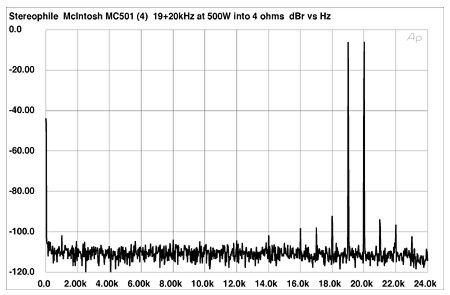
Fig.10 McIntosh MC501, 4 ohm tap, HF intermodulation spectrum, DC-24kHz, 19+20kHz at 500W into 4 ohms (linear frequency scale).
I thought the McIntosh amplifiers sounded simply superb when I auditioned them in Paul Bolin's system in the spring. Nothing in the MC501's measured performance causes me to doubt what I heard.—John Atkinson
- Log in or register to post comments




































